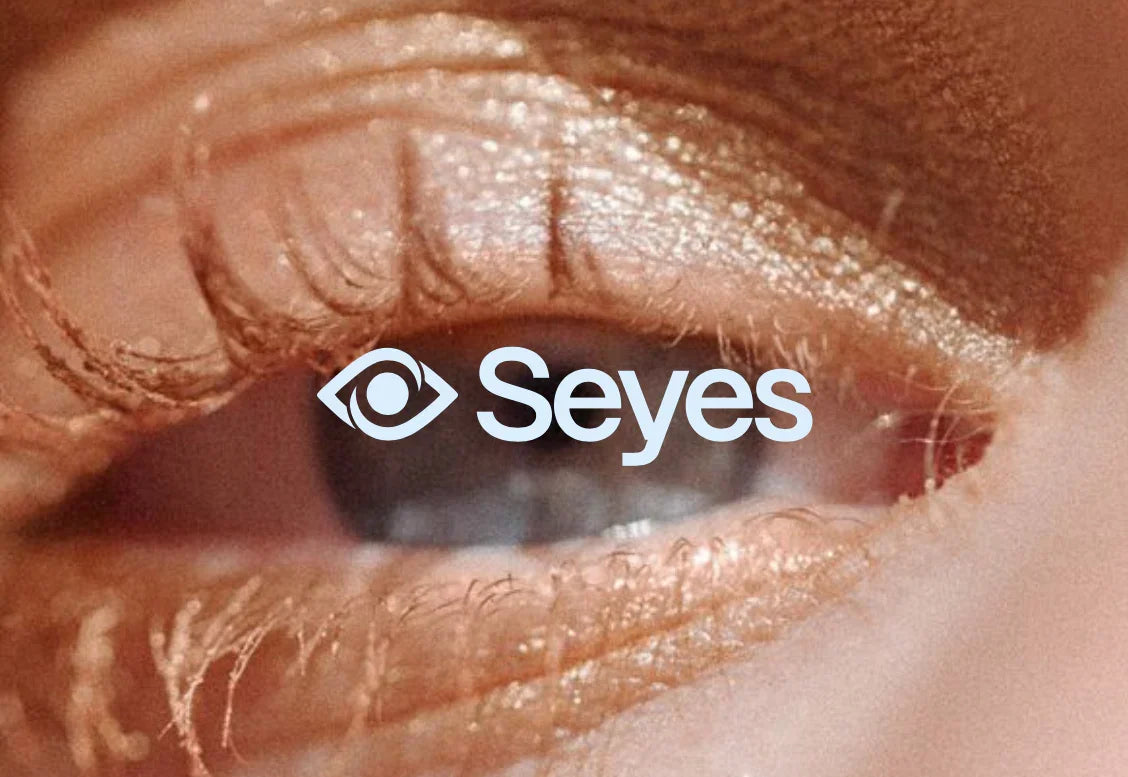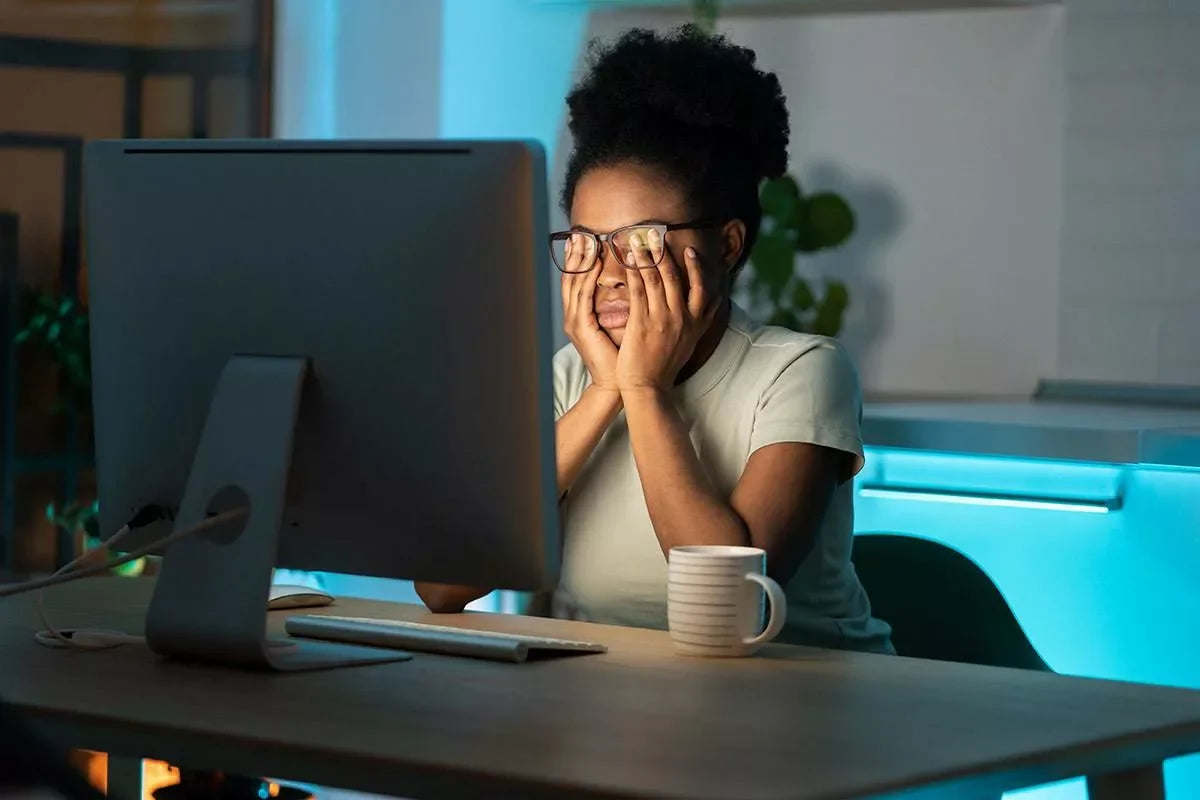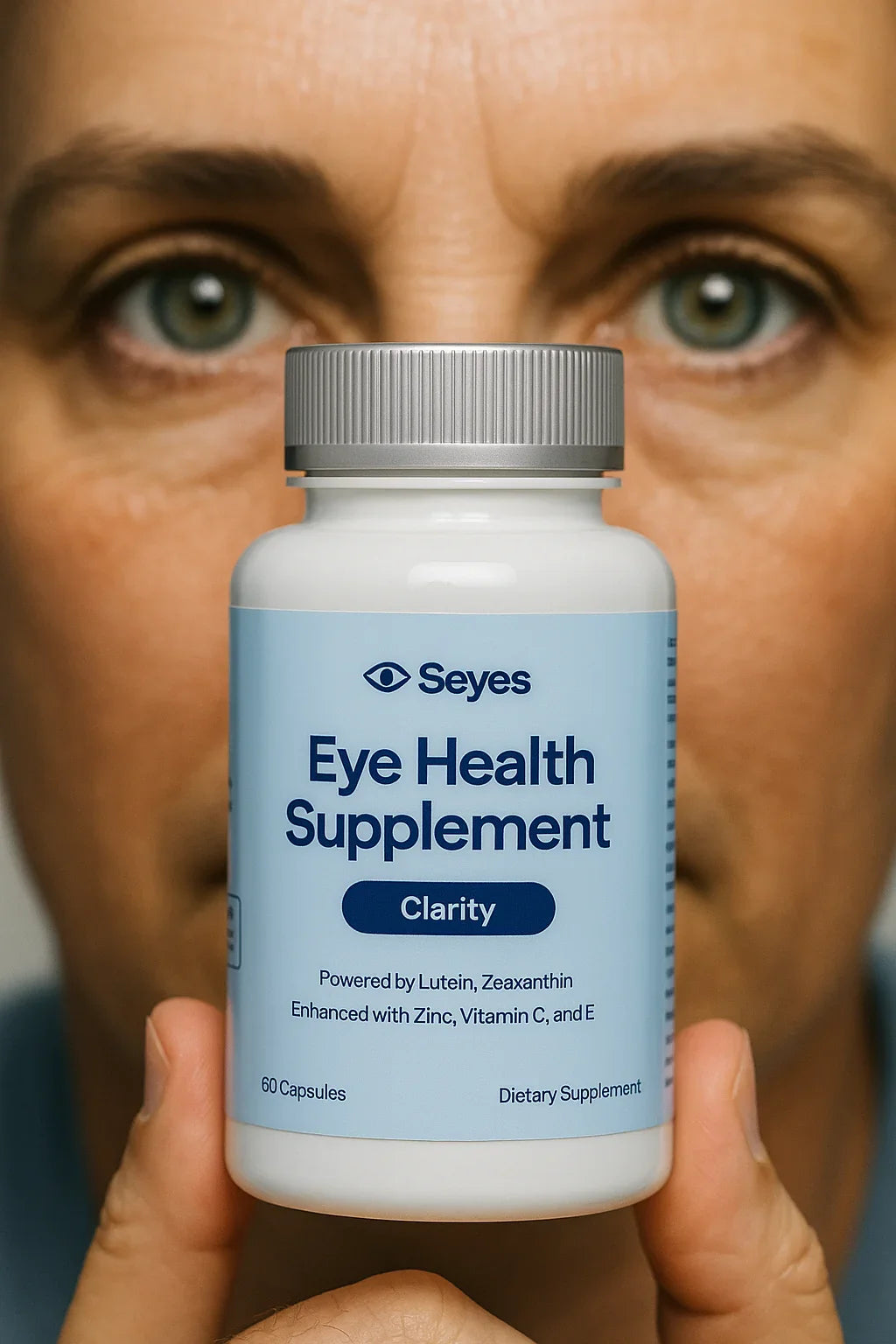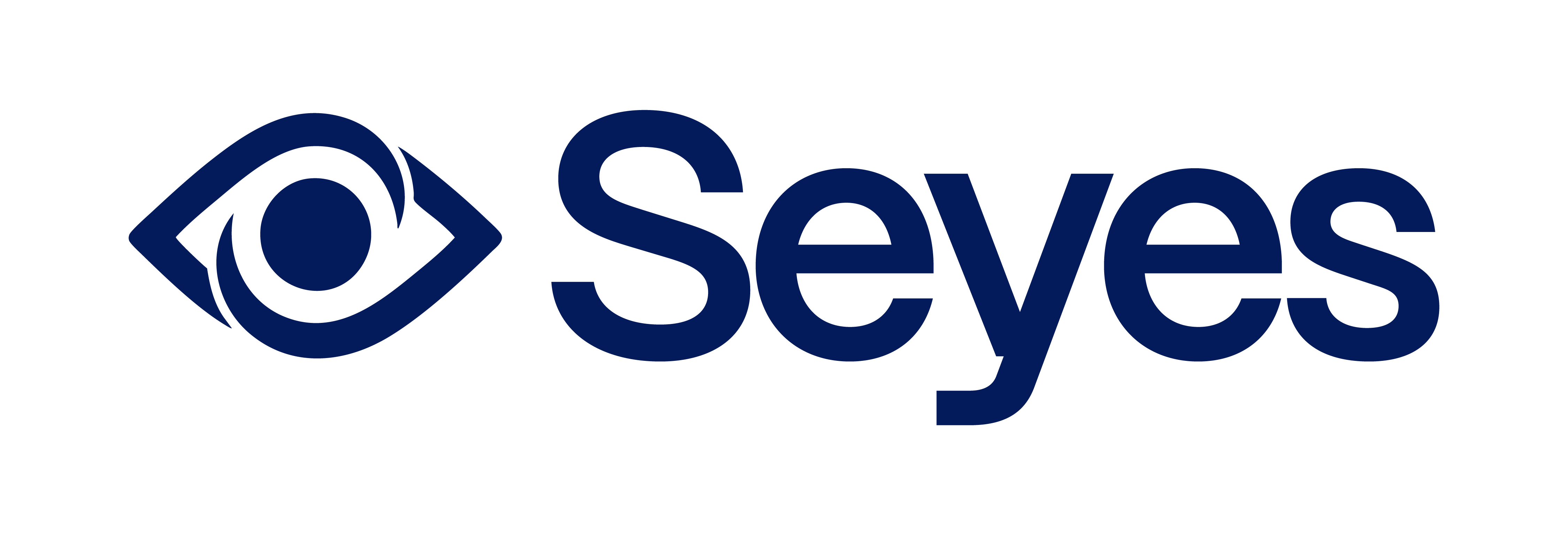Blog

Dry Eye 101: Everyday Fixes That Help
Dry eyes are a daily struggle for many, especially with screens and AC. In this guide, Seyes breaks down common causes, symptoms, and simple fixes—from warm compresses and artificial tears to smart contact lens habits.

Digital Eye Strain (Computer Vision Syndrome): Causes, Fixes, and What Actually Works
Seyes Blog
Digital Eye Strain (Computer Vision Syndrome): Causes, Fixes, and What Actually Works
Eye Health Aug 29, 2025 • 7 min read
Contents
1. TL;DR
2. What is digital eye strain?
3. Common symptoms
4. Why it happens (the short version)
5. Fixes that work (step-by-step)
6. Screen, lighting, and environment
7. Dry eye overlap & relief tips
8. Kids & teens
9. Myths & nice-to-haves
10. When to see an eye-care professional
1. TL;DR
Digital eye strain is a combination of visual demand (focus and convergence) and surface issues (reduced blinking, tear evaporation). Most people improve with better ergonomics, frequent breaks, and dry-eye–friendly habits. Blue-light hype is overrated; lighting, distance, and breaks matter more.
2. What is digital eye strain?
Sometimes called “Computer Vision Syndrome,” it’s eye discomfort linked to prolonged screen use—desktops, laptops, tablets, and phones. It’s not just about the eyes: posture, lighting, and screen setup play big roles.
3. Common symptoms
Tired, sore, or burning eyes
Blur or fluctuating focus, especially late in the day
Headaches around the brow/temples
Light sensitivity or glare discomfort
Dry, gritty sensation; watery eyes (paradoxical)
Neck/shoulder tension from posture
4. Why it happens (the short version)
Reduced blink rate: On screens, blink rate can drop by ~50%, which destabilizes the tear film.
Continuous near focus: Ciliary muscles work to keep text clear; long stretches cause fatigue.
Glare & contrast: Harsh lighting or reflections force your visual system to work harder.
Posture & distance: Screens too high/close strain focusing and neck muscles.
5. Fixes that work (step-by-step)
20–20–20 rule: Every 20 minutes, look 20 feet away for 20 seconds. Set a gentle timer.
Blink on purpose: During breaks, do 10 slow, full blinks. Consider “blink cues” (sticky note, phone reminder).
Screen 20–28 inches away, slightly below eye level: Top of screen ~2–3 inches below your eye height.
Increase text and zoom: Use larger fonts and proper contrast; avoid squinting.
Balanced lighting: Soften overheads, add a desk lamp, reduce glare. Avoid facing bright windows.
Use night/dark mode for comfort (not a cure-all): Pick what’s easiest to read.
Consider task glasses: Single-vision “computer” prescription can reduce focusing effort if you’re symptomatic.
Glasses users: If you wear progressives, a dedicated computer pair can be a game changer for long desk sessions.
6. Screen, lighting, and environment
Anti-glare: Matte screen protectors or anti-reflective coatings help in bright offices.
Refresh rate: Higher refresh can reduce perceived flicker on some displays.
Room setup: Keep background illumination similar to screen brightness; avoid high-contrast extremes.
Posture: Feet flat, hips back, shoulders relaxed, wrists neutral. Small changes = big relief.
7. Dry eye overlap & relief tips
Artificial tears: Preservative-free drops as needed; gels/ointments at night if recommended by your clinician.
Warm compress + lid hygiene: Helps oil glands, stabilizing the tear film.
Humidify: Indoor humidity 40–50% can help; avoid direct fans toward your face.
Contact lens wearers: Consider reduced wear time on heavy screen days or talk to your provider about different materials.
Medication check: Some meds (and AC/heating) can worsen dryness—ask your provider if symptoms persist.
8. Kids & teens
Encourage outdoor time; it helps overall visual comfort and healthy habits.
Use bigger screens for schoolwork when possible; keep devices at arm’s length.
Breaks matter: try 20–20–20 and movement every class period or study session.
9. Myths & nice-to-haves
Blue-light glasses fix everything
They may change comfort for some, but the biggest wins usually come from distance, breaks, blinking, lighting, and ergonomics.
Dark mode prevents eye strain
It can feel nicer in dim rooms, but readability and contrast trump theme choice. Use what lets you read effortlessly.
10. When to see an eye-care professional
Book an eye exam if you have persistent headaches, double vision, frequent blur, new floaters/flashes, eye pain, or if symptoms don’t improve with the steps above. You may need a prescription update or evaluation for dry eye or binocular vision issues.
Share Email
Explore more
Science
Ingredient Sources & Transparency
Lab Tests & Certifications
American Foundation for the Blind
Contact Us
Disclaimer: Educational content only; not medical advice. For personal guidance, consult your eye-care professional.
Previous article
‹ Lutein vs. Zeaxanthin: What’s the Difference?
Next article
How to Read a COA (Certificate of Analysis) ›

Lutein vs. Zeaxanthin: What’s the Difference?
Seyes Blog
Lutein vs. Zeaxanthin: What’s the Difference?
Ingredients Jun 30, 2025 • 6 min read
Contents
1. TL;DR
2. What they are & where they’re found
3. Macular pigment & vision
4. Human evidence (AREDS2)
5. Diet vs. supplements
6. Forms & bioavailability
7. Typical amounts & safety
8. FAQs
9. References
1. TL;DR
Lutein and zeaxanthin are carotenoids that concentrate in the macula of your retina, forming the macular pigment that filters short-wavelength light and supports visual performance. In the AREDS2 trial, replacing beta-carotene with lutein/zeaxanthin created a widely used formulation for people with intermediate age-related macular degeneration (AMD).
2. What they are & where they’re found
Feature
Lutein
Zeaxanthin
Common sources
Marigold (Tagetes erecta), spinach, kale
Marigold (co-extract), orange peppers, corn, egg yolk
Spectral peak
~446 nm
~452 nm
Macular distribution
Higher toward the macular periphery
Higher in the foveal center (incl. meso-zeaxanthin)
Primary role
Antioxidants; contribute to the blue-light filtering macular pigment
Dark leafy greens are reliable dietary sources; supplements standardize dose and consistency.
3. Macular pigment & vision
The macular pigment is rich in lutein and zeaxanthin. It absorbs short-wavelength light and may help reduce chromatic aberration and glare sensitivity. Observational research links higher macular pigment optical density (MPOD) with certain measures of visual performance.
Reminder: Observational links don’t prove causation; randomized trials offer stronger evidence for specific outcomes.
4. Human evidence (AREDS2)
AREDS2 randomized trial: Replacing beta-carotene with lutein (10 mg) + zeaxanthin (2 mg) provided a widely used alternative for people at risk of progression to advanced AMD.
Follow-up analyses & long-term data: Support the AREDS2 approach and safety profile over time.
For context and links, see our Science page.
5. Diet vs. supplements
Diet: Typical US intake is ~1–3 mg/day combined carotenoids (varies widely). Dark greens, orange/yellow produce, and eggs contribute.
Supplements: Standardized doses help individuals reach amounts studied in trials (e.g., 10 mg lutein + 2 mg zeaxanthin in AREDS2).
Quality: Look for products publishing batch testing—see our Lab Tests & Certifications and Ingredient Sources & Transparency.
6. Forms & bioavailability
Free lutein vs. lutein esters: Both are used in supplements; esters are hydrolyzed in the gut. Practical differences in healthy adults are modest when taken with dietary fat.
Delivery forms: Oil suspensions and beadlets are common; take with a meal containing fat to support absorption.
Label clarity: Check whether amounts are given as lutein and zeaxanthin (not beta-carotene).
7. Typical amounts & safety
Common supplemental amounts: 10 mg lutein + 2 mg zeaxanthin per day (AREDS2 pattern).
No established US Daily Value: There’s no federally set DV/RDA for lutein/zeaxanthin.
Safety: Generally well-tolerated; high carotenoid intake can rarely cause harmless yellowing of the skin (carotenodermia). As always, talk to your eye-care professional, especially if pregnant, nursing, smoking, or managing a medical condition.
Not medical advice: Personal needs vary. Discuss supplements with your clinician.
8. FAQs
Is meso-zeaxanthin necessary?
Meso-zeaxanthin occurs in the macula (centrally) and can form from lutein in the body. Many products use lutein + zeaxanthin without adding meso-zeaxanthin; discuss options with your eye-care professional.
Can I get enough from food alone?
Some people can, especially with frequent dark leafy greens and colorful produce. Supplements help standardize daily intake if diet varies.
Why did AREDS2 remove beta-carotene?
To address safety concerns in smokers and focus on macular pigments used in the retina (lutein/zeaxanthin).
9. References
AREDS2 primary RCT: JAMA (2013)
Long-term follow-up: JAMA Ophthalmology (2022)
Background review on lutein/zeaxanthin in the retina: Annu Rev Nutr (2003)
Our research summary: Seyes Science
Previous article
‹ Understanding Heavy Metals in Supplements
Next article
How to Read a COA (Certificate of Analysis) ›
Explore more
Science
Ingredient Sources & Transparency
Lab Tests & Certifications
American Foundation for the Blind
Contact Us
Share Email
Disclaimer: Educational content only; not medical advice. For personal guidance, consult your eye-care professional.

Understanding Heavy Metals in Supplements: What Your COA Shows (and How to Read It)
Seyes Blog
Understanding Heavy Metals in Supplements: What Your COA Shows (and How to Read It)
Lab & QA Jul 18, 2025 • 5 min read
Contents
1. TL;DR
2. Why heavy metals show up
3. The four we monitor (Pb, Cd, Hg, As)
4. How labs test (ICP-MS) & units
5. How to read a COA result
6. Our internal approach (US)
7. Quick calculator: ppm → µg per serving
8. FAQs
9. More transparency
1. TL;DR
Trace amounts of heavy metals can appear in botanicals and minerals because they come from soil and water. That’s why every batch is screened for lead (Pb), cadmium (Cd), mercury (Hg), and arsenic (As). Labs typically use ICP-MS and report results in ppm (mg/kg) or ppb (µg/kg). Your COA should show the method, result, and the specification it was checked against.
2. Why heavy metals show up
Natural background: Plants absorb minerals—including trace metals—from the environment.
Processing: Concentrating extracts can also concentrate trace elements.
Packaging & handling: Good manufacturing controls minimize any added contamination.
Key point: Presence ≠ problem. What matters is how much is present and whether it meets the product’s specification.
3. The four we monitor (Pb, Cd, Hg, As)
Metal
Why we check it
Typical sources
Notes
Lead (Pb)
Neurotoxic at elevated exposure
Soil, dust, older infrastructure
Reported as ppm or ppb; often lowest-possible limits
Cadmium (Cd)
Kidney accumulation risk
Soil; certain crops
Watch concentrated botanical powders
Mercury (Hg)
Neurotoxic; methyl-Hg in fish
Marine oils; environment
For plant capsules, usually very low/ND
Arsenic (As)
Toxic at higher exposure
Water/soil
Sometimes spec differentiates inorganic As
4. How labs test (ICP-MS) & units
Method
ICP-MS (inductively coupled plasma mass spectrometry) is the go-to technique for multi-element trace analysis. Samples are digested (acid + heat), atomized in plasma, and quantified by mass spectrometry against certified standards.
Units you’ll see
ppm = mg/kg = µg/g
ppb = µg/kg = ng/g
ND = not detected (below the method’s detection/quantitation limit)
LoD vs. LoQ: LoD is the smallest signal detectable; LoQ is the lowest level you can quantify with confidence. COAs often list one or both.
5. How to read a COA result
Find the panel: Look for “Heavy Metals,” “Elemental Impurities,” or similar.
Check the method: ICP-MS (preferred). Method/SOP ID should be listed.
Compare result vs. spec: The COA should show a Result and a Specification (limit). “Pass/Fail” indicates compliance.
Convert to per-serving (optional): If your result is in ppm (µg/g), multiply by grams per serving to get µg/serving.
Example: Lead result = 0.25 ppm (i.e. 0.25 µg/g). Capsule fill weight = 0.6 g. Exposure per serving = 0.25 × 0.6 = 0.15 µg.
6. Our internal approach (US)
Spec drafting: We maintain internal specifications for Pb, Cd, Hg, and As for each product.
Supplier controls: Supplier qualification + incoming COAs for key raw materials.
Batch release: Third-party lab testing for finished product before shipment.
Transparency: See our Lab Tests & Certifications page for the testing overview and document list.
Heads-up: Exact acceptance limits vary by product and internal spec. Always refer to the latest COA for your batch.
7. Quick calculator: ppm → µg per serving
Enter your COA value and serving weight to estimate µg per serving.
Analyte (optional)
Result (ppm)
Serving weight (g)
Exposure (µg/serving)
Calculate See our lab page
Note: This tool is for educational use only. For compliance decisions, rely on the COA and your product specification.
8. FAQs
Is “ND” the same as zero?
No—“not detected” means the analyte was below the method’s detection/quantitation limit.
Why does the COA list arsenic without saying “inorganic”?
Some specs use total arsenic, others specify inorganic arsenic. Your COA or spec will state which applies.
Do mineral ingredients (e.g., zinc, magnesium) affect heavy metal results?
Not directly. The lab method isolates trace impurities. We test each finished batch to verify compliance.
Where can I find the limits?
Limits are defined in our internal specification for each product. Check the “Specification” column on your COA and our lab page for the testing framework.
9. More transparency
Lab Tests & Certifications
Ingredient Sources & Transparency
Science
Contact Us
Share Email
Disclaimer: Educational content only; not medical or legal advice. For personal guidance, consult your healthcare professional.
Previous article
‹ How AREDS2 Shapes Modern Eye Health Supplements
Next article
Lutein vs. Zeaxanthin: What’s the Difference? ›

How AREDS2 Shapes Modern Eye Health Supplements
Seyes Blog
How AREDS2 Shapes Modern Eye Health Supplements
Science Aug 1, 2025 • 7 min read
Contents
1. TL;DR
2. AREDS vs. AREDS2—what changed?
3. Who actually benefits?
4. Dosage realities & label reading
5. Common myths
6. Practical takeaways
7. References
1. TL;DR
The strongest human evidence for eye-health supplements comes from the AREDS and AREDS2 clinical trials. The key finding: in people with intermediate age-related macular degeneration (AMD), a specific antioxidant + zinc formula slowed progression to advanced AMD. AREDS2 updated the original by removing beta-carotene and using lutein + zeaxanthin instead.
These results do not mean everyone should take an AREDS-style formula for prevention—benefits were shown for a defined group (intermediate AMD).
2. AREDS vs. AREDS2—what changed?
AREDS (2001):
Antioxidants (vitamin C, vitamin E) + zinc (with copper for safety).
Outcome: lowered risk of progression to advanced AMD in high-risk participants.
AREDS2 (2013):
Replaced beta-carotene with lutein + zeaxanthin.
Explored adding omega-3s (DHA/EPA)—no additional benefit when added to the formulation.
10-year follow-up supports the AREDS2 approach as a widely used standard.
AREDS/AREDS2 inform modern formulas; labs verify identity, potency, and safety of each batch.
Why remove beta-carotene? Safety concerns in smokers and the availability of macular pigments (lutein/zeaxanthin) that directly accumulate in the retina.
3. Who actually benefits?
Evidence supports use in intermediate AMD. If you don’t have AMD—or you have only early drusen—routine use for “prevention” isn’t supported by these trials. Always discuss with your eye-care professional, especially if you smoke, are pregnant, or take medications.
4. Dosage realities & label reading
Macular pigments: Lutein + zeaxanthin are the carotenoids used in AREDS2. Check labels for their amounts (not beta-carotene).
Zinc + copper: High-dose zinc is paired with copper to help prevent copper-deficiency anemia.
Omega-3: Important nutritionally, but adding DHA/EPA to the AREDS2 formula did not add AMD benefit in trials.
Tip: Look for brands that publish a COA (Certificate of Analysis) for identity, potency, microbiology, and heavy metals.
5. Common myths
“Everyone should take AREDS2.”
Not true. The benefit applies to people with intermediate AMD under trial conditions. It isn’t a general prevention pill.
“More omega-3s will fix AMD.”
Omega-3s are healthy fats, but in AREDS2, adding DHA/EPA to the formula didn’t improve AMD outcomes.
“Any capsule with lutein is the same as AREDS2.”
Formulations vary a lot. Check full composition, strengths, and quality testing.
6. Practical takeaways
If you’ve been diagnosed with intermediate AMD, ask your clinician about an AREDS2-style formula.
Prefer products that publish batch-level testing (lab page).
For ingredient origins and standardization, see Ingredient Sources & Transparency.
For study summaries and broader context, visit our Science page.
Share Email
Disclaimer: This article is for education only and isn’t medical advice. Talk to your eye-care professional for personal recommendations.
7. References
National Eye Institute – AREDS summary: NEI.gov
AREDS2 primary RCT: JAMA (2013)
AREDS2 10-year follow-on: JAMA Ophthalmology (2022)
Background on omega-3 & eye: NEJM (2018, DREAM)
Previous article
‹ Understanding Heavy Metals in Supplements
Next article
Lutein vs. Zeaxanthin: What’s the Difference? ›
Explore more
Science
Ingredient Sources & Transparency
Lab Tests & Certifications
American Foundation for the Blind
Contact Us
